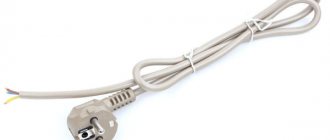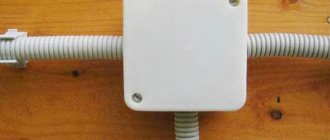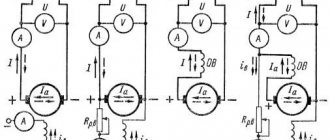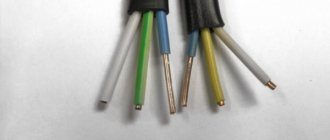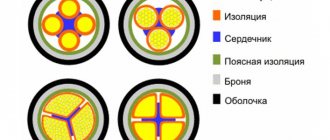How many kilowatts will SIP withstand?
While browsing the internet for electrical installations, I found a thread on one forum discussing “whether a 4x16 sip can withstand 15 kW.”
The question arises because 15 kW 380 volts are allocated for connecting a private house. Well, people are wondering if it’s not enough to lay 16 square meters on a branch from the overhead line? I first looked into the PUE, but for some reason I didn’t find anything there on the topic of SIP power. There is only plate 1.3.29 “Permissible long-term current for non-insulated wires according to GOST 839-80.” And it shows that the maximum permissible current for the cross section is 16 kV. mm. wire type AC, ASKS, ASK outdoors is 111 amperes. Well, at least something to start with.
Wire installation
Laying work must be carried out at temperatures above -20 degrees. If it is lower, you need to wait for stable natural warming. If the wire is installed in a location with a high fire hazard, care must be taken to take protective measures, for example, covering the lines to protect against fire. During the cold season, the presence of icing or snow on the cable does not cause malfunctions in its operation. Placing wiring along the walls allows you to save resources on the construction of support configurations.
Pole mounting
How many kilowatts can a 4x16 SIP withstand?
But there is GOST 31943-2012 “Self-supporting insulated and protected wires for overhead power lines.” At the end of the standard, in paragraph 10 of the operating instructions, there is a sign
| SIP section | voltage 380V (3-phase load) | voltage 220V (1 phase load) |
| SIP 4x16 | 62 kW | 22 kW |
| SIP 4x25 | 80 kW | 29 kW |
| SIP 4x35 | 99 kW | 35 kW |
| SIP 4x50 | 121 kW | 43 kW |
| SIP 4x70 | 149 kW | 53 kW |
| SIP 4x95 | 186 kW | 66 kW |
| SIP 4x120 | 211 kW | 75 kW |
| SIP 4x150 | 236 kW | 84 kW |
| SIP 4x185 | 270 kW | 96 kW |
| SIP 4x240 | 320 kW | 113 kW |
Test after installation
The rules for accepting overhead lines are described in the standards for distribution networks with a voltage of 380-20,000 volts. It is necessary to measure the resistance of the core insulation using a megger, sharpened to work with a voltage of 1 kilovolt. Measure data between zero and each phase. Also, all phases are paired with each other and with the lighting line. If in one of the measurements the indicator exceeds 0.5 MOhm, an insulation breakdown may be suspected. Using a similar 2.5 kilovolt device, you can check the quality of the insulation. The same pairs of cores are tested. If the layer is not damaged, it is considered reliable.
This SIP series cable is well suited for arranging transmission lines. The availability of installation options that do not require the installation of additional supports allows you to save resources.
Calculation method (update from 02/19/2018)
for single-phase load 220V P=U*I
for three-phase load 380V P=(I1+I2+I3)\3*cos φ*1.732*0.38
update from 02/19/2018 Regarding the calculation of power for a three-phase load, you need to understand that a lot depends on the type of consumers (more precisely, what kind of load they provide active or reactive, it depends on what cos φ should be substituted into the formula, in this case for calculations it is equal to 0.95 )
Therefore, if the value of the load you need is closer than 10% to the table, you should choose a larger section of the vulture from the list. Let me explain with the example of 120 kW. According to the table, for this three-phase load, a SIP with a conductor cross-section of 50 mm is suitable, but this is less than 10%. That is, 121 kW * 0.9 = 109 kW. Accordingly, you need to choose SIP 3x70+1x54.6.
At the beginning of the topic, the question was raised: “will a 4x16 15kW sip handle it?” Therefore, for a private house we multiply 220Vx100A = 22 kW per phase. But don’t forget that we have three phases. And this is already 66 kilowatts in total for a residential building. Which is a 4-fold margin relative to the issued technical conditions.
Source
Technical characteristics of SIP-4 4*16
Wire weight SIP-4 4x16
Theoretical weight of 1 kilometer SIP-4 4x16: 269.00 kilograms
The mass of aluminum in 1 meter of wire is 0.18 kg.
The weight of the wire depends on the specifications of the specific manufacturer. To calculate the weight of the SIP-4 4x16 cable with a drum, use our weight calculator.
The cables must be wound on drums.
Wire diameter SIP-4 4x16
Outer diameter of wire SIP-4 4x16: 17.8 millimeters
The outer diameter of the section depends on the specifications of a particular plant; at the end of the page you can familiarize yourself with the manufacturers, from whom you can clarify the information.
The dimensions of the wire are taken into account when calculating and correctly selecting wire-carrying systems.
Installation rules for SIP-4 4x16
First of all, cable paths are laid, after which it is necessary to connect the power network, which will be the source of energy for the premises.
Installation process
It must be remembered that the connection to a cable without an insulation layer is made through corrugations with a sealed compound, as well as using clamps. In this case, you need to strip the edge of the wire and then compress it with a press. It is allowed to use branch clamps required for wires without a supporting core.
You may be interested in this Wire marking designation
Wire installation
The technology for installing SIP wires does not present any particular difficulties. Thanks to this, with the proper skill and free time, you can complete all the work yourself. But in order to install the SIP cable yourself, you must first coordinate the work with government services. In addition, before you begin installing the SIP wire to the house, you need to obtain permission from the company supplying electricity. In order to correctly carry out all work on connecting the line, you need to carefully study the recommendations of specialists. The step-by-step instructions for installing SIP wires say: 1. First of all, you need to select a product of the required cross-section. Most often, for installing SIP cables from a pole to a house, products with a cross-section of 15 mm are used. 2. If the extension line exceeds 25 m, you will need to install additional support and use a tensioner.
3. In the case when it is necessary to branch the SIP cable line, additional components will be needed for installation - a special clamp. With its help, you can make punctures on the pole in the right places. The advantages of using clamps include simplified installation - you will not need to strip the cable. Next, the installation of the SIP cable from the pole to the building is carried out according to the following plan: 1. Attach special fasteners to the support. Fasteners are necessary to ensure a strong connection. 2. Install the clamp. To do this, among the components for installing SIP wires there must be an anchor-type clamping device. It is a fitting with a bracket. 3. If wood was used for the construction of the building, according to the rules for installing SIP cables, additional insulation of the wire must be performed. To carry out wiring to stone or brick houses, there is no need to additionally insulate the wire. 4. Lead the wire 1 m into the building. 5. Make a branch inside the house. To correctly install SIP wires inside a building, you can watch a video. If necessary, a special coupling may be required to connect the cables.
Rules for storage and transportation of SIP-4 4x16
Like any cable product, SIP wires must be stored in a dry warehouse, otherwise there is a risk of mold.
Cable storage in a warehouse
Reels with wire should stand on the edges, and not lie on their sides. This may damage the outer layer of insulation. Outdoor storage is allowed, but away from direct sunlight. From time to time you need to check the integrity of the packaging and wires, because if there are rodents in the warehouse, they can damage the outer sheath.
It is necessary to transport reels of wires only in a special loader. The drums must be secured so that they do not roll around the body during transportation. Loading and unloading operations are carried out using special equipment.
Attention! Placing coils of wires on the ground without additional supports is not allowed. Neglecting this rule can lead to mechanical damage to the outer sheath, which will cause the conductors to overheat and cause a short circuit.
Transportation of products
How many kilowatts will SIP withstand?
While browsing the internet for electrical installations, I found a thread on one forum discussing “whether a 4x16 sip can withstand 15 kW.” The question arises because 15 kW 380 volts are allocated for connecting a private house. Well, people are wondering if it’s not enough to lay 16 square meters on a branch from the overhead line? I first looked into the PUE, but for some reason I didn’t find anything there on the topic of SIP power.
There is only plate 1.3.29 “Permissible long-term current for non-insulated wires according to GOST 839-80.” And it shows that the maximum permissible current for the cross section is 16 kV. mm. wire type AC, ASKS, ASK outdoors is 111 amperes. Well, at least something to start with.
How many kilowatts can a 4x16 SIP withstand?
But there is GOST 31943-2012 “Self-supporting insulated and protected wires for overhead power lines.” At the end of the standard, in paragraph 10 of the operating instructions, there is a sign
How many kilowatts can SIP withstand - table:
SIP section voltage 380V (3-phase load) voltage 220V (1-phase load)
| SIP 4x16 | 62 kW | 22 kW |
| SIP 4x25 | 80 kW | 29 kW |
| SIP 4x35 | 99 kW | 35 kW |
| SIP 4x50 | 121 kW | 43 kW |
| SIP 4x70 | 149 kW | 53 kW |
| SIP 4x95 | 186 kW | 66 kW |
| SIP 4x120 | 211 kW | 75 kW |
| SIP 4x150 | 236 kW | 84 kW |
| SIP 4x185 | 270 kW | 96 kW |
| SIP 4x240 | 320 kW | 113 kW |
Calculation method (update from 02/19/2018)
We take plate 10 and from it we find that one core is 16 sq. mm. withstands - 100 amperes. Next, we take the following calculation formulas:
for single-phase load 220V P=U*I
for three-phase load 380V P=(I1+I2+I3)\3*cos φ*1.732*0.38
update from 02/19/2018 Regarding the calculation of power for a three-phase load, you need to understand that a lot depends on the type of consumers (more precisely, what kind of load they provide active or reactive, it depends on what cos φ should be substituted into the formula, in this case for calculations it is equal to 0.95 )
Dear visitors to the site, I might not have noticed your caustic but technically correct comments on the article if just today a person called me with the question: “what kind of sip do I need for 120 kW?” According to the sign, a SIP with a cross section of 50 mm square would be perfect for him. Even if we omit the fact that the length of the line affects the voltage drop (it has 150 meters), we should not forget that the load on the phases can vary, as can be seen from the formula - it takes the average value for three phases. Here you just need to understand that the phase current can exceed the maximum permissible values for a given wire cross-section.
Therefore, if the value of the load you need is closer than 10% to the table, you should choose a larger section of the vulture from the list. Let me explain with the example of 120 kW. According to the table, for this three-phase load, a SIP with a conductor cross-section of 50 mm is suitable, but this is less than 10%. That is, 121 kW * 0.9 = 109 kW. Accordingly, you need to choose SIP 3x70+1x54.6.
At the beginning of the topic, the question was raised: “will a 4x16 15kW sip handle it?” Therefore, for a private house we multiply 220Vx100A = 22 kW per phase. But don’t forget that we have three phases. And this is already 66 kilowatts in total for a residential building. Which is a 4-fold margin relative to the issued technical conditions.
Selecting the cable cross-section according to power
You can select the wire cross-section according to the power of the devices that will be connected. These devices are called load and the method can also be called “by load”. Its essence does not change from this.
The choice of cable cross-section depends on the power and current
Collecting data
First, find the power consumption in the passport data of household appliances and write it down on a piece of paper. If it’s easier, you can look at nameplates - metal plates or stickers attached to the body of equipment and equipment. There is basic information and, more often than not, power. The easiest way to identify it is by its units of measurement. If a product is manufactured in Russia, Belarus, or Ukraine, it is usually designated W or kW; on equipment from Europe, Asia or America, the English designation for watts is usually W, and the power consumption (this is what is needed) is designated by the abbreviation “TOT” or TOT MAX.
Example of a nameplate with basic technical information. There is something similar on any technology
If this source is also unavailable (the information has become lost, for example, or you are just planning to purchase equipment, but have not yet decided on the model), you can take the average statistical data. For convenience, they are summarized in a table.
Table of power consumption of various electrical appliances
Find the equipment you plan to install and write down the power. Sometimes it is given with a wide spread, so sometimes it is difficult to understand which figure to take. In this case, it is better to take the maximum. As a result, when calculating, you will slightly overestimate the power of the equipment and will need a cable with a larger cross-section. But for calculating the cable cross-section it is good. Only cables with a smaller cross-section than necessary will burn. Routes with a large cross-section work for a long time, as they heat up less.
The essence of the method
To select the wire cross-section for the load, add up the power of the devices that will be connected to this conductor
It is important that all powers are expressed in the same units of measurement - either in watts (W) or in kilowatts (kW). If there are different values, we bring them to a single result
To convert, kilowatts are multiplied by 1000 to get watts. For example, let's convert 1.5 kW into watts. This will be 1.5 kW * 1000 = 1500 W.
If necessary, you can carry out the reverse conversion - convert watts to kilowatts. To do this, divide the figure in watts by 1000 to get kW. For example, 500 W / 1000 = 0.5 kW.
Next, the selection of the cable cross-section actually begins. It's very simple - we use a table.
| Cable cross-section, mm2 | Conductor diameter, mm | Copper wire | Aluminum wire | ||||
| Current, A | power, kWt | Current, A | power, kWt | ||||
| 220 V | 380 V | 220 V | 380 V | ||||
| 0.5 mm2 | 0.80 mm | 6 A | 1.3 kW | 2.3 kW | |||
| 0.75 mm2 | 0.98 mm | 10 A | 2.2 kW | 3.8 kW | |||
| 1.0 mm2 | 1.13 mm | 14 A | 3.1 kW | 5.3 kW | |||
| 1.5 mm2 | 1.38 mm | 15 A | 3.3 kW | 5.7 kW | 10 A | 2.2 kW | 3.8 kW |
| 2.0 mm2 | 1.60 mm | 19 A | 4.2 kW | 7.2 kW | 14 A | 3.1 kW | 5.3 kW |
| 2.5 mm2 | 1.78 mm | 21 A | 4.6 kW | 8.0 kW | 16 A | 3.5 kW | 6.1 kW |
| 4.0 mm2 | 2.26 mm | 27 A | 5.9 kW | 10.3 kW | 21 A | 4.6 kW | 8.0 kW |
| 6.0 mm2 | 2.76 mm | 34 A | 7.5 kW | 12.9 kW | 26 A | 5.7 kW | 9.9 kW |
| 10.0 mm2 | 3.57 mm | 50 A | 11.0 kW | 19.0 kW | 38 A | 8.4 kW | 14.4 kW |
| 16.0 mm2 | 4.51 mm | 80 A | 17.6 kW | 30.4 kW | 55 A | 12.1 kW | 20.9 kW |
| 25.0 mm2 | 5.64 mm | 100 A | 22.0 kW | 38.0 kW | 65 A | 14.3 kW | 24.7 kW |
To find the required cable cross-section in the corresponding column - 220 V or 380 V - we find a figure that is equal to or slightly greater than the power we previously calculated. We select the column based on how many phases are in your network. Single-phase - 220 V, three-phase 380 V.
In the found line, look at the value in the first column. This will be the required cable cross-section for a given load (power consumption of devices). You will need to look for a cable with cores of this cross-section.
A little about whether to use copper wire or aluminum. In most cases, when laying wiring in a house or apartment, cables with copper conductors are used. Such cables are more expensive than aluminum ones, but they are more flexible, have a smaller cross-section, and are easier to work with. But copper cables with a large cross-section are no more flexible than aluminum ones. And under heavy loads - at the entrance to a house or apartment with a large planned power (from 10 kW or more), it is more advisable to use a cable with aluminum conductors - you can save a little.
Cable design SIP-4 4x16
Inside the product there is a cable core that acts as a conductor. It is made from aluminum alloy in accordance with GOST No52373-2004. The cable cores can be sectored or round and consist of a certain number of wires that are twisted into a tight bundle.
Power line installations
The internal cores are also made of aluminum, sometimes copper is used in the composition. External insulation is made of PVC materials. This shell may be flammable or non-flammable. The first option is used more often, which provides additional safety for the operation of power lines.
Wire installation
The technology for installing SIP wires does not present any particular difficulties. Thanks to this, with the proper skill and free time, you can complete all the work yourself. But in order to install the SIP cable yourself, you must first coordinate the work with government services. In addition, before you begin installing the SIP wire to the house, you need to obtain permission from the company supplying electricity. In order to correctly carry out all the work on connecting the line, you need to carefully study the recommendations of specialists. The step-by-step instructions for installing SIP wires say: 1. First of all, you need to select a product of the required cross-section. Most often, for installing SIP cables from a pole to a house, products with a cross-section of 15 mm are used. 2. If the extension line exceeds 25 m, you will need to install additional support and use a tensioner.
3. In the case when it is necessary to branch the SIP cable line, additional components will be needed for installation - a special clamp. With its help, you can make punctures on the pole in the right places. The advantages of using clamps include simplified installation - you will not need to strip the cable. Next, installation of the SIP cable from the pole to the building is carried out according to the following plan: 1. Attach special fasteners to the support. Fasteners are necessary to ensure a strong connection. 2. Install the clamp. To do this, among the components for installing SIP wires there must be an anchor-type clamping device. It is a fitting with a bracket. 3. If wood was used for the construction of the building, according to the rules for installing SIP cables, additional insulation of the wire must be performed. To carry out wiring to stone or brick houses, there is no need to additionally insulate the wire. 4. Lead the wire 1 m into the building. 5. Make a branch inside the house. To correctly install SIP wires inside a building, you can watch a video. If necessary, a special coupling may be required to connect the cables.
Wire design
SIP cable
Unlike cables of a number of other brands, which include copper cores, the sip 4x16 wire has them made of aluminum. Traditional cable options use pure metal, but models with the letter H in the marking (SIP-4N) use an alloy. Each conductive core is multi-wire and consists of a large number of wire elements combined into dense bundles. The cross-sectional shape of the core components of conductors from different manufacturers can be not only round, but also sector-shaped.
Important! Each of the cores has an insulating coating made of cross-linked polymer material with thermoplastic properties. Most often this is polyethylene coated with a light-stabilizing compound. Usually the wires are pure black, but some manufacturers provide them with colored inserts.
Cable storage
Selection of SIP section
The selection and calculation of the cross-section of SIP wires for connecting various consumer objects is carried out using the classical method. The maximum power consumption of electrical installations is added up, and the current load is calculated using the formula:
– P – total power consumption;
– I – maximum current consumption;
– U – network voltage.
Based on the value of the maximum current, you should select the required cross-section of SIP wires using pre-calculated tables.
Parameters of the most used SIP cables for connecting buildings from the main power lines (SIP-1, SIP-1A, SIP-2, SIP-2A)
| branches from overhead lines; | for installation of overhead lines with voltage 6-35 kV | branches from overhead lines; | branches from overhead lines; | |
| Section in mm and number of cores | Phase resistance in Ohm per 1 km | Maximum permissible phase current with thermoplastic insulation | Maximum permissible phase current with cross-linked polyethylene | Short circuit current in kA for a duration of 1s |
| 1x16+1x25 | 1.91 | 75 | 105 | 1 |
| 2x16 | 1.91 | 75 | 105 | 1 |
| 2x25 | 1.2 | 100 | 135 | 1.6 |
| 3x16 | 1.91 | 70 | 100 | 1 |
| 3x25 | 1.2 | 95 | 130 | 1.6 |
| 3x16+1x25 | 1.91 | 70 | 100 | 1 |
| 3x25+1x35 | 1.2 | 95 | 130 | 1.6 |
| 3x120 +1x95 | 0.25 | 250 | 340 | 5.9 |
| 3x95+1x95 | 0.32 | 220 | 300 | 5.2 |
| 3x95+1x70 | 0.32 | 220 | 300 | 5.2 |
| 3x50+1x95 | 0.44 | 180 | 240 | 4.5 |
| 3x70+1x70 | 0.44 | 180 | 240 | 4.5 |
| 3x50+1x70 | 0.64 | 140 | 195 | 3.2 |
| 3x50+1x50 | 0.64 | 140 | 195 | 3.2 |
| 3x35+1x50 | 0.87 | 115 | 160 | 2.3 |
| 3x25+1x35 | 1.2 | 95 | 130 | 1.6 |
| 3x16+1x25 | 1.91 | 70 | 100 | 1 |
| 4x16+1x25 | 1.91 | 70 | 100 | 1 |
| 4x25+1x35 | 1.2 | 95 | 130 | 1.2 |
When choosing the cross-section and brand of SIP wires, it is important to take into account not only the maximum current load, but also the temperature and the time during which the cable can be operated in extreme conditions. Typically the allowable duration is 4000 to 5000 hours
Maximum temperature for wires
| Operating modes | Maximum temperature for wire | |
| Thermoplastic insulation SIP-1, SIP-1A, SIP-4 | Cross-linked polyethylene SIP-2, SIP-2A, SIP-3, SIP-5 | |
| norm | 70 | 90 |
| during overloads | 80 | 130 |
| in case of a short circuit lasting up to 5 seconds | 135 | 250 |
When choosing the brand of SIP cable and its heating cross-section, you must take into account the type of insulation: cross-linked polyethylene or thermoplastic. Taking into account voltage losses, thermal resistance during short circuit, mechanical strength, if one of the parameters is insufficient, a cable with a large cross-section is selected.
When operating a SIP cable, overloads are allowed up to 8 hours a day, 100 hours a year and no more than 1000 hours for the entire period of operation. Most often, SIP-2A is used to connect residential buildings or commercial facilities, this is due to some disadvantages of other cable models:
From the above table it can be seen that the SIP-2A cable can have the same or different core cross-sections. Typically, when the cross-section of the phase conductors is 70 sq./mm, the zero conductor for strength is made 95 mm/sq. With a larger cross-section of phases, the carrier phase is not increased; the mechanical strength is quite sufficient. With a uniform distribution of electricity across phases, the zero conductor experiences virtually no electrical and thermal load. For lighting networks, cables with a core cross-section of 16 or 25 sq./mm are usually used.
Rules for choosing wire SIP-4 4x16
In order to choose the right wire, you need to calculate its cross-section. Very thin cables will have a fairly high resistance, causing the wires to overheat, and if the temperature is too high, a short circuit or fire will occur.
Important! There are special tables that spell out the rules for selecting suitable sections for a certain voltage.
Also, when choosing SIP-4, it is necessary to determine the insulating layer of the wire. For areas with high intensity of sunlight, it is advisable to buy wires with a sheath made of light-stabilized polyethylene.
Correct attachment to the pole
If there is a risk of sudden external overheating, it is necessary to give preference to a non-combustible shell. If the cable is laid in places with significant temperature differences, it is advisable to choose products with thermoplastic insulation.
Important! When choosing, you must perform a visual inspection of the product. If the integrity of the packaging is damaged, then such a cable is not worth purchasing. You can also request a certificate of conformity, which indicates the manufacturer, the date of production of the product and its full name. If there is no such document, then it may be a fake. Before purchasing, you need to study the most popular factories and look for their products.
